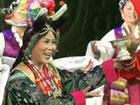| Videos | • Latest |
|
• Feature | • Sports | • Your Videos |
Tibet Opera troupe celebrates 50 years

Tibet Opera, a major form of entertainment in southwest China, is on the road to better preservation, thanks to a move from plazas to theaters.
A performance by the Tibet Opera Troupe is now showcasing what local artists are doing to protect their legacy on stage. Let's find out how.
The celebratory performance of the Tibet Opera Troupe, marking the ensemble's 50th anniversary, brought together both veteran and budding artists, to entertain an enthusiastic local audience.
Excerpts from both traditional repertoires and new creations chronicled the development of the artform. Tibet Opera took shape in 14th and 15th centuries.
But it was not until 1960 that the first local troupe was established. Over the ensuing 50 years, the ensemble has evolved from staging classics like "Princess Wencheng," to putting on new attractions like "Duoxiong's Spring." They also delight local fans with a variety of short sketches.
Langga, Vice Director, Tibet Opera Troupe, said, "From plazas to theaters, opera has developed fast. The settings and music have been greatly polished. We also emphasize the nurturing of talents. We have a lot of national-class performers."
Photos and objects on display at the Exhibition Hall of the Tibet Opera Troupe inform visitors of the genre's history and culture. They can also learn unique styles of make-up, costumes, and accessories.
Tibet Opera normally showcases the theme of historical legends, and usually features performers wearing masks to portray different roles.
In 2006, the genre was inscribed as a National Intangible Heritage, and three years later, it won world recognition as a UNESCO Human Intangible Heritage.
 0
0 







Go to Forum >>0 Comments